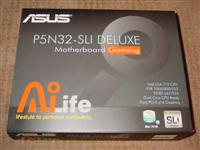Asus P5N32-SLI Deluxe nForce4 SLI X16 Intel Edition
When NVIDIA first resurrected the term "SLI" from the technology archives, it was welcomed back with open arms. Although the exact definition has changed from it's 3Dfx roots, it boils down to two graphics cards working on the same job. The obvious benefit is that two cards should be able to easily outperform even the fastest single card. The only real problem for some users was that the technology was limited to owners of nForce-based motherboards, and initially that meant having an AMD Athlon processor. NVIDIA eventually decided to address Intel's huge install-base as well, and nForce 4 SLI - Intel Edition motherboards arrived on the scene.
It has only been six months since we first got a look at those boards, and there's already some room for improvement. In our initial reviews, the boards handled the benchmarks well, Occasionally outperforming Intel's lineup consisting of i915 and i925X chipset at the time. As we mentioned, Intel chipset based boards don't offer SLI support at all (althought the recently introduced i975X does support ATi Crossfire technology), making the nForce 4-SLI boards a top choice for hardware enthusiasts. A downside of the original nForce4-SLI chipset, however, was that the chipset's total number of PCIe lanes was limited to 20 and PEG slots had to share the 16 PCI Express lanes allocated to graphics. However NVIDIA's recently launched nForce 4 SLI X16 chipset also comes in both AMD and Intel flavors, with the "X16" standing for 16 devoted lanes for each PEG slot for 32 lanes total. As usual, Asus is one of the first to market, releasing the P5N32-SLI Deluxe, complimenting their P5ND2-SLI offering. Read on to find out whether it's always a good thing to be first in line.



CLICK ON ANY IMAGE FOR A CLOSER VIEW
|
| Processor - Supports Socket 775 for Intel EE / Pentium D / Pentium 4 / Celeron D processors - Compatible with Intel 05B/05A and 04B/04A processors - Supports Intel Hyper-Threading / EM64T / EIST Front Side Bus - 1066/800/533MHz Chipset - NVIDIA nForce4 SLI X16 Intel Edition Memory - Four 240-pin DIMM sockets - Supports Dual channel DDR2 667/533 Non-ECC memory - Supports maximum memory capacity up to 16GB LAN - Dual Gigabit LAN featuring AI Net2 - NVIDIA nForce4 SLI Southbridge built-in Gigabit MAC with external Marvell PHY supports NV Active Armor and NV Firewall - Marvell PCI-E Gigabit LAN Storage/RAID - NVIDIA nForce4 SLI supports NVRAID - supports RAID 0, 1, 0+1, 5, and JBOD - 2 x Ultra DMA 133/100/66/33 - 4 x Serial ATA 3 GB/s - Silicon Image 3132 SATA controller - supports RAID 0, 1 - 1 x Internal Serial ATA 3 GB/s hard disk - 1 x External Serial ATA hard disk (SATA on-the-go) Audio - Realtek ALC850 8-channel CODEC - Universal Audio Jack - Auto jack sensing and enumeration technology - Coaxial/Optical S/PDIF out ports on back I/O IEEE 1394 - TI 1394a controller supports 2IEEE 1394a connectors |
SLI ASUS AI Life Features |
  |
The Bundle: Asus usually provides varying bundle types that consist of the same board but have added components (with the expected added price). The version we received for testing was called the "P5N32-SLI Deluxe". It's a close twin of the top of the line model with the only piece missing being a WiFi/TV Tuner combo similar to the card we found with the Asus P5WD2 Premium. Other than that notable omission, the bundle of cables, cords, and other connectors is quite complete - well deserving of the board's vast capabilities. Starting from the inside out, there were 4 SATA cables, and four SATA power cables to go along with them. It's a fair amount, although since there are actually five connectors on board, ASUS should probably have thrown in that extra cable. Complementing the list of supported drives, there were two flat, black ribbon cables, one for the floppy drive and one for an IDE device, such as a DVD-ROM drive. Unlike many of the other manufacturer's boards we've reviewed, ASUS has typically shied away from including rounded cables, which can help cut down on cable clutter. Moving to the optional brackets that can be installed, we found an external FireWire port, 2 USB 2.0 and a GAME/MIDI ports, and a legacy COM port. To round out the bundle, there's an I/O shield and SLI connector that's long enough to support the extra spacing that the P5N32-SLI affords. For installation purposes, ASUS provided us a manual and driver CD, as well as a WinDVD suite CD and case badge. The driver CD includes typical chipset and component drivers as well as utilities from ASUS and NVIDIA such as NVIDIA's NVFirewall and ASUS' PC Probe 2, which we will take a look at a bit later. |






